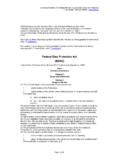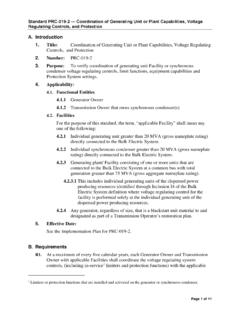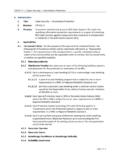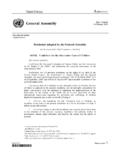Transcription of Musicians' hearing protection: A review - RR664
1 Health and Safety Executive Musicians' hearing protection A review Prepared by the Health and Safety Laboratory for the Health and Safety Executive 2008. RR664 . Research Report Health and Safety Executive Musicians' hearing protection A review Jacqueline Patel BSc (Hons) MSc (Eng) MPhil MIOA. Health and Safety Laboratory Harpur Hill Buxton Derbyshire SK17 9JN. The music and entertainment industry is unique in that high noise levels are often regarded as an essential element for the enjoyment of people attending concerts and live music events.
2 However, there is a risk of hearing damage for people working in the music and entertainment industry, including musicians. One of the methods used to reduce noise exposure is the use of appropriate hearing protection . Many different types of hearing protection have been marketed for musicians including premoulded earplugs, custom-moulded earplugs and in-ear monitors. In order to support the Health and Safety Executive's (HSE) understanding of this issue, the types of hearing protection available to musicians were identified. Telephone interviews were then conducted with nineteen professional musicians to collect information on: the type of hearing protection (if any) musicians are currently using; musicians' attitudes to hearing protection including whether they think it is, or it can be, effective and whether it allows them to do their job effectively; and the factors musicians consider important when choosing hearing protection .
3 This report and the work it describes were funded by the Health and Safety Executive (HSE). Its contents, including any opinions and/or conclusions expressed, are those of the author alone and do not necessarily reflect HSE policy. HSE Books Crown copyright 2008. First published 2008. All rights reserved. No part of this publication may be reproduced, stored in a retrieval system, or transmitted in any form or by any means (electronic, mechanical, photocopying, recording or otherwise) without the prior written permission of the copyright owner.
4 Applications for reproduction should be made in writing to: Licensing Division, Her Majesty's Stationery Office, St Clements House, 2-16 Colegate, Norwich NR3 1BQ. or by e-mail to ii ACKNOWLEDGEMENTS. The author gratefully acknowledges those who assisted in this project, in particular the musicians who took part in the telephone interviews. iii iv CONTENTS. 1 2 hearing PROTECTOR TYPES ..2. Earmuffs ..2. Earplugs ..2. Sound restoration level-dependent hearing Flat or tailored frequency response hearing protectors ..4. hearing protectors with in-built communication 3 hearing PROTECTORS FOR MUSICIANS.
5 5. Noise Attenuation characteristics ..5. Occlusion Commercially available musicians' hearing protection ..6. 4 MUSICIANS' ATTITUDES TO hearing PROTECTORS A. LITERATURE review ..11. Reasons for wearing hearing Reasons for not wearing hearing Types of hearing protectors being used ..12. General conclusions about hearing protector usage ..13. 5 MUSICIANS' ATTITUDES TO hearing protection TELEPHONE. Sampling Topics covered during the telephone Analysis ..14. Results ..15. Discussion of telephone interview data ..29. 6 7 8 REFERENCES ..36. APPENDIX A: LITERATURE SEARCH APPENDIX B: MUSICIANS' NOISE EXPOSURE.
6 40. APPENDIX C: MUSICIANS' APPENDIX D: TOPICS COVERED DURING TELEPHONE INTERVIEWS. WITH v vi EXECUTIVE SUMMARY. Objectives The music and entertainment industry is unique in that high noise levels are often regarded as an essential element for the enjoyment of people attending concerts and live music events. However, there is a risk of hearing damage for people working in the music and entertainment industry, including musicians. One of the methods used to reduce noise exposure is the use of appropriate hearing protection . Many different types of hearing protection have been marketed for musicians including premoulded earplugs, custom-moulded earplugs and in-ear monitors.
7 In order to support the Health and Safety Executive's (HSE) understanding of this issue, the types of hearing protection available to musicians were identified. Telephone interviews were then conducted with nineteen professional musicians to collect information on: the type of hearing protection (if any) musicians are currently using; musicians' attitudes to hearing protection including whether they think it is, or it can be, effective and whether it allows them to do their job effectively; and the factors musicians consider important when choosing hearing protection .
8 Main Findings Semi-structured telephone interviews were conducted with nineteen musicians between June and October 2007 to gain an understanding of their attitude towards using hearing protection , and on the performance and usability of available hearing protectors. Although the sample was small it was well represented across the different types of instruments played, how long the musicians had played professionally, and the range of work experiences. The majority interviewed were classical musicians playing in large orchestras. However, the views of three freelance percussionists and two military band players provided some insight into the experiences of other types of musicians playing different styles of music and in different venues.
9 The findings presented in this report were obtained from telephone interviews with musicians and from discussions with, and information provided by, hearing protector manufacturers and suppliers. Musicians most commonly use conventional foam and flange earplugs because they are easy to fit during a performance, and they are often the most readily available. However conventional protectors can provide too much protection when fitted properly, and they can cause musicians to mishear or overplay as a result of the lack of high frequency sound heard through the protectors.
10 Musicians are most likely to wear conventional hearing protectors when they are exposed to very loud music generated by other musicians. Premoulded musicians' earplugs provide moderate attenuation but preserve sound quality. They are a relatively inexpensive off-the-shelf earplug, and are reusable if kept clean. They can improve sound quality for those musicians working with or around amplified sound. Custom-moulded musicians' earplugs use interchangeable filters to provide different levels of protection (9 - 25 dB), and have been designed to preserve a natural sound quality.


















